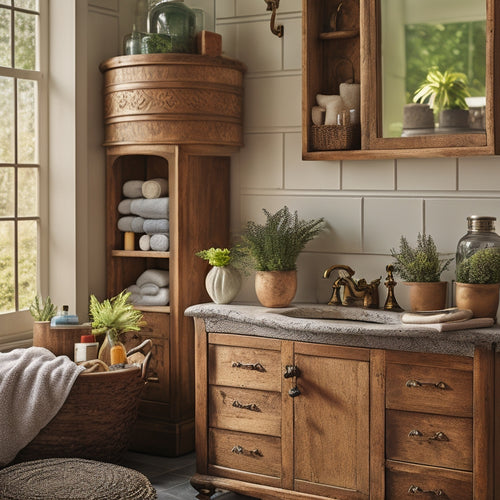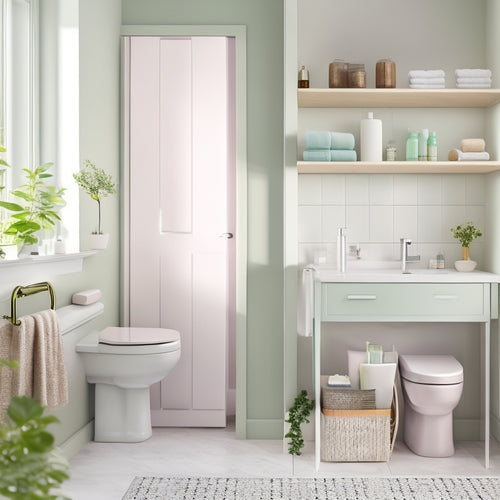
How to Create a Built-in Medicine Cabinet in the Wall
Share
You'll start by planning your built-in medicine cabinet, considering factors like wall space, storage solutions, accessibility features, aesthetic elements, and ventilation options. Measure the installation space, noting obstacles, and choose materials that fit your desired aesthetic, budget, and functionality. Next, cut wall openings, taking care around insulation, and assemble the cabinet frame using sturdy materials. Install cabinet doors, adding shelves and lighting as needed. With a solid foundation in place, you're ready to add the finishing touches, including decorative trim and organizer systems - and that's just the beginning of creating a seamless and functional built-in medicine cabinet.
Key Takeaways
- Measure the installation space, noting plumbing and electrical obstructions, to establish maximum cabinet size and determine storage solutions.
- Choose durable materials suitable for humid environments, such as MDF or solid wood, and consider ventilation options to protect medications.
- Cut wall openings carefully, using a stud finder and level, and consult professionals for cuts in load-bearing walls to ensure safety.
- Design and assemble the cabinet frame to fit wall openings and specifications, using screws, nails, or a combination for stability.
- Install cabinet doors, shelves, and lighting, ensuring proper fit, alignment, and functionality, and add finishing touches for a seamless appearance.
Planning the Medicine Cabinet
Measure the space where you'll install the medicine cabinet, considering any obstructions like plumbing or electrical outlets. This will help you determine the maximum size of your cabinet and plan your design considerations.
Think about the storage solutions you need - do you want shelves, drawers, or a combination of both? Consider accessibility features like adjustable shelves or a pull-out drawer for easy access.
Aesthetic choices like the style of the cabinet door, the finish, and the hardware will also impact the overall look of your bathroom. Don't forget to think about ventilation options, like a vented cabinet or a dehumidifying system, to keep the space dry and fresh.
For customization ideas, consider adding a mirror, a USB outlet, or a charging station. Safety measures like a lock or a child-safety latch are also important to prevent accidents.
Measuring the Wall Space
With your design considerations in mind, it's time to get precise about the space where your medicine cabinet will live. Take out your trusty tape measure and get ready to get up close and personal with your wall.
You'll need to record the wall measurements to determine the maximum size of your cabinet. Measure the width of the wall space, taking note of any obstacles like electrical outlets or plumbing fixtures.
Next, measure the height of the space, considering the distance from the floor to the top of the wall. Don't forget to factor in any space considerations, like the distance from the ceiling or any adjacent cabinetry.
You'll also want to measure the depth of the wall to determine how far your cabinet can protrude. Write down these measurements and keep them handy – you'll need them to choose the perfect cabinet size and configure the interior layout.
Choosing the Right Materials
Several factors will influence your material selection for the built-in medicine cabinet, including your desired aesthetic, budget, and functional requirements.
You'll want to choose materials that not only look great but also meet the demands of a humid bathroom environment. Consider materials with high material durability, such as MDF or solid wood, to guarantee your cabinet withstands the test of time.
When it comes to aesthetic choices, think about color coordination and texture variety. You may want to match your cabinet to your bathroom's existing decor or create a bold contrast.
Don't forget about insulation options to keep your medications at the right temperature. Since bathrooms are prone to moisture, look for materials with moisture resistance, like waterproof plywood or PVC-coated MDF.
Cutting the Wall Openings
Behind the drywall, you'll find the studs that will guide your cutting process. Use a stud finder to locate them, and mark their positions with a pencil.
Now, it's time to cut out the openings for your medicine cabinet. Depending on your wall type, you might need to cut through drywall, plaster, or even brick. Be prepared to adapt your cutting method accordingly.
For walls with insulation, take extra precautions to avoid damaging it. Use a utility knife or a drywall saw to carefully cut around the insulation, and gently remove it from the opening.
If you're dealing with a load-bearing wall, consult a professional to verify your cuts won't compromise the structural integrity.
Measure twice, cut once – or in this case, measure thrice, cut once. Double-check your marks and measurements before making the cut. Use a level to verify your cuts are straight and level.
Building the Cabinet Frame
You'll start building the cabinet frame by designing it to fit your wall openings and medicine cabinet specifications.
Consider the frame's width, height, and depth, as well as the type of materials you'll use, such as MDF or plywood.
Once you have a solid design, you can begin assembling the frame using screws, nails, or a combination of both.
Cabinet Frame Design
Three essential components make up the cabinet frame: the sides, top, and shelves.
You'll need to decide on the design aesthetics and frame styles that fit your bathroom's unique vibe. Are you going for sleek and modern or traditional and ornate? Perhaps a mix of both? Consider the style of your bathroom fixtures, the color scheme, and the overall ambiance you want to create.
When designing your cabinet frame, think about the functionality you need. Will you have adjustable shelves or fixed ones? Do you want a single door or double doors that swing open to reveal your neatly organized medicine cabinet?
Make a list of the must-haves and nice-to-haves to guide your design decisions.
Measure your wall space carefully to determine the maximum size of your cabinet frame. Don't forget to account for any obstructions, like plumbing or electrical outlets.
With your design and measurements in hand, you're ready to start building your cabinet frame.
Frame Assembly Process
With your design and measurements in hand, grab your power tools and get ready to bring your cabinet frame to life.
You'll need your frame materials, including 2x4 lumber for the sides, top, and bottom, and 1x4 lumber for the shelves. Cut these pieces according to your design, using a miter saw or circular saw.
Next, assemble the frame using your frame tools, such as a drill press, impact driver, and clamps. Start by building the sides, attaching the top and bottom pieces to create a rectangular box.
Then, add the shelves, making sure they're level and evenly spaced. Use wood glue and 2 1/4" wood screws to secure everything in place.
As you work, double-check your measurements to guarantee everything fits together perfectly. Don't be afraid to use clamps to hold pieces in place while you attach them.
With your frame assembled, you'll be ready to add the back panel, shelves, and door. Take a step back and admire your handiwork – you're one step closer to having a sleek, built-in medicine cabinet!
Installing the Cabinet Doors
You'll now focus on installing the cabinet doors, starting with assembling the door frames according to your design specifications.
Next, you'll attach the hinges to the door frames and the cabinet frame, ensuring proper alignment and secure attachment.
Follow the manufacturer's instructions for hinge installation, as the process may vary depending on the type of hinges you're using.
Door Frame Assembly
Assemble the door frame by attaching the hinges to the cabinet side panels, confirming they're aligned with the door's hinge recesses.
Use frame materials like wood or MDF to create a sturdy frame that can support the weight of the doors and any contents. You'll need to cut the frame pieces to size using a miter saw or a circular saw, and then assemble them using wood glue and nails or screws.
When assembling the frame, make sure to use precise assembly techniques to guarantee it's square and level. You can use clamps to hold the pieces in place while the glue dries.
If you're using a pre-made frame kit, follow the manufacturer's instructions for assembly.
Once the frame is assembled, attach the hinges to the cabinet side panels, making sure they're aligned with the door's hinge recesses. This will confirm a smooth opening and closing action.
Take your time and double-check your measurements to avoid any mistakes. With a solid door frame in place, you'll be ready to move on to the next step: installing the cabinet doors.
Hinge Installation Process
How carefully have you measured the hinge recesses on your cabinet doors? Don't worry, it's an easy mistake to make, but an essential one to avoid.
Now that you've got your door frame assembled, it's time to install the cabinet doors. You'll need to choose the right hinge type for your medicine cabinet - soft-close, semi-concealed, or fully concealed. Each type has its own installation requirements, so make sure you follow the manufacturer's instructions.
When it comes to hinge placement, precision is key. Mark the spot where you want to install the hinge, considering the door's opening direction and the cabinet's frame.
Use a drill press or a jigsaw to create the recesses, and attach the hinges to the door and cabinet frame. Make sure they're aligned properly and securely fastened.
Double-check that the doors open and close smoothly before moving on to the next step. With your hinges installed, you're one step closer to having a fully functional built-in medicine cabinet.
Adding Shelves and Lighting
Your medicine cabinet's functionality depends on clever shelving and thoughtful lighting. You want to maximize storage without making the space feel cramped. Consider the items you'll be storing and group similar items together. For example, store medications on one shelf and skincare products on another.
When it comes to shelf spacing, aim for 6-8 inches between each shelf. This allows for easy access and visibility. You can also adjust the shelf spacing based on the size of the items you're storing.
Here's a breakdown of some popular lighting options for your medicine cabinet:
| Lighting Option | Description |
|---|---|
| LED Strip Lighting | Energy-efficient and provides soft, ambient light |
| Under-Shelf Lighting | Highlights specific areas and creates a modern look |
| Recessed Lighting | Provides task lighting and makes the space feel larger |
| Glass Shelf Lighting | Adds a touch of elegance and sophistication |
Remember to choose lighting that complements your cabinet's design and provides the right amount of illumination for your needs.
Finishing Touches and Assembly
With all the essential components in place, it's time to focus on the finishing touches that will bring your built-in medicine cabinet to life. This is where you get to add the cherries on top - the details that make your cabinet aesthetically pleasing and functional.
-
Add a decorative trim to conceal any gaps between the cabinet and the wall, giving it a seamless look.
-
Install a soft-close hinge to guarantee the door shuts quietly and smoothly.
-
Add a cabinet organizer system to maximize storage and keep your essentials within easy reach.
- Top it off with a stylish mirror or a decorative panel to complete the look.
Now that you've added these finishing touches, it's time to assemble the cabinet. Follow the manufacturer's instructions to attach the shelves, doors, and any other components.
Make certain everything is level, plumb, and securely fastened. With these final steps, you'll be enjoying your new built-in medicine cabinet in no time!
Frequently Asked Questions
Can I Install a Medicine Cabinet in a Load-Bearing Wall?
You're wondering if you can install a medicine cabinet in a load-bearing wall? Well, you can, but don't mess with the structural considerations, or you'll be left holding the wall up - literally! Use proper installation techniques to avoid a DIY disaster.
How Do I Protect the Cabinet From Moisture and Humidity?
You're smart to worry about moisture and humidity! To protect your cabinet, you'll want to install moisture barriers, like a waterproof membrane, and consider ventilation options, such as a dehumidistat or fans, to keep the air circulating and dry.
Are There Any Specific Regulations for Medicine Cabinet Installation?
Ah, the pesky regulations! As you steer through installation guidelines, remember: safety standards are your BFFs. Check with local authorities for specific requirements, ensuring your cabinet meets electrical, plumbing, and accessibility codes - don't let red tape get in the way of your DIY high!
Can I Add Electrical Outlets Inside the Medicine Cabinet?
You're wondering if you can add electrical outlets inside the medicine cabinet - a genius idea! Consider lighting options like LED strips or puck lights, but prioritize safety considerations, like waterproofing and GFCI outlets, to avoid electrical shocks and fires.
How Do I Clean and Maintain the Medicine Cabinet Over Time?
You'll want to establish a maintenance schedule to keep your medicine cabinet spick and span. Set prompts for regular cleaning, and follow these cleaning tips: wipe shelves with a damp cloth, toss expired meds, and vacuum out dust bunnies!
Conclusion
You've successfully built a built-in medicine cabinet that's a real-life Pandora's box of organization and functionality - minus the chaos, of course! With your new cabinet, you'll be able to store all your essentials within easy reach, just like a pharmacist dispensing wisdom. Now, go forth and fill it with all your medicinal treasures, and reap the benefits of your handiwork.
Related Posts
-

Multi-Functional Vintage Bathroom Storage Units
Multi-functional vintage bathroom storage units merge style with function, helping you create an organized and aesthe...
-

Wall-Mounted Bathroom Organizers for Small Spaces
Wall-mounted bathroom organizers are perfect for maximizing storage in small spaces. By utilizing vertical space, you...
-

Revamp Your Home With Spring Cleaning Checklist
Spring's arrival presents a prime opportunity to transform your living space, shedding the remnants of winter's hiber...


